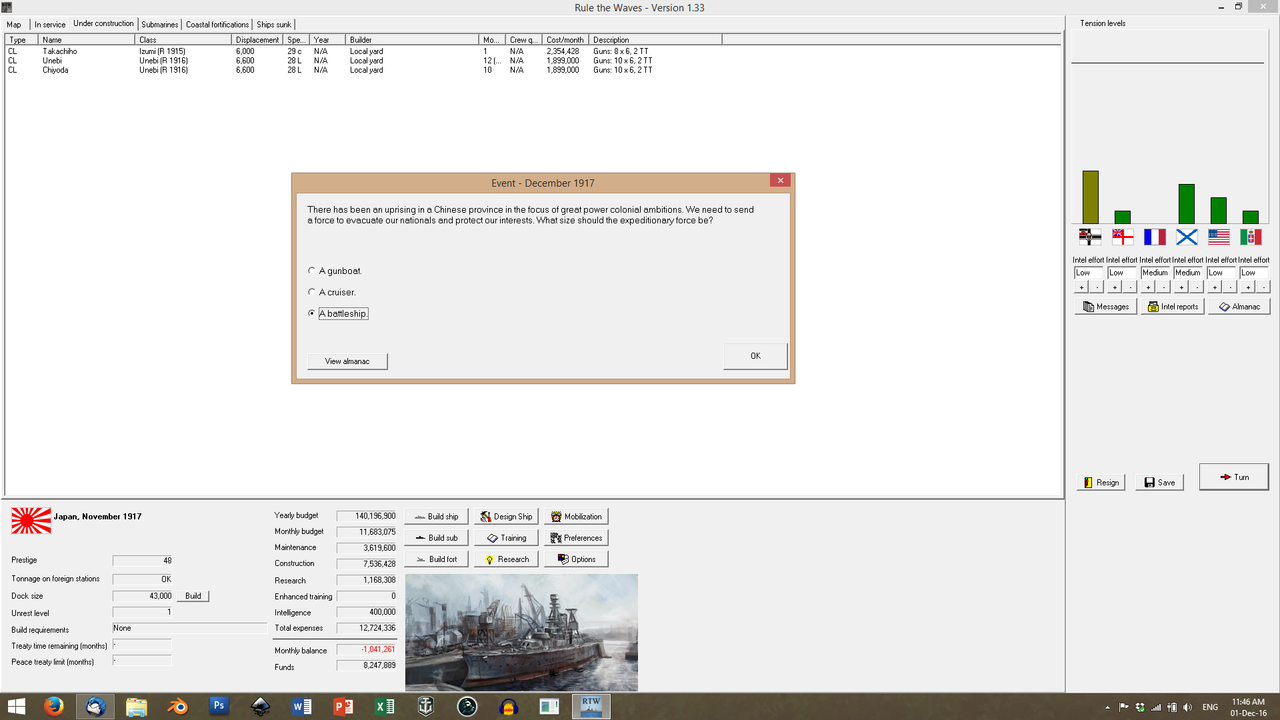
In September 1917, elections brought a new Government to power, under Hara Takashi. The new Prime Minister was noteworthy in that he was a commoner and a Christian; he was also one of the strongest believers in further developing Japan's holdings overseas. In that, he did follow Katō's vision.
He was also an enemy to the Navy. having once failed to pass the entrance exams to the Officer's Academy. One of the first motions that he sought to pass was to assign part of the Naval budget to commission a new yacht for the Imperial family. The Admiralty could do little but to grin and bear it.

And, behind closed doors they
did grin. For the Tsingtaou foundries had
finally produced a working prototype of a 13'' rifle. Too late to be refitted to the
Fuso, but what the Admiralty thought might be the backbone of their future capital ship fleet.

However, tensions between the Admiralty and Hara quickly brought the situation to its boiling point when the Prime Minister suggested adopting a conciliatory stance toward Germany. The proposal, as put forward by Germany, would require the Japanese Navy to put a large part of its forces in reserve 'in the interest of world peace' and other platitudes of the sort. A committee of seven Vice- and Rear Admirals was formed, under the revered Admiral Fujiwara; with the backing of most of the Alliance's industrialists, they succeeded in having the proposals shelved and the Naval budget raised to a reasonable yearly amount.

Germany did
not appreciate that. In November, an uprising near Hong Kong, later proved to be instigated by German agents, resulted in
Fuso being dispatched to the area, with a small destroyer escort and an Army convoy. Like her predecessor, her presence (and the Army contingent she brought to the scene) succeeded in putting an end to the uprising; like her predecessor, she thoroughly rattled the
status quo in the area and tensions skyrocketed, with only Woodrow Wilson's America applauding the rapid Japanese response, in the interests of 'democracy, security and international peace'.


Shortly after, the R & D department submitted working designs for Cruiser-mounted above-water torpedo mounts...

...five more long-range subs were laid down...


...and the Italians approached the Admiralty with knowing grins and the chemical formulae for improved AP projectile explosive fillers, for some reason printed in
German. The Admiralty winked back and paid them a good price.

Then, in January, things got explosive again.
 Fuso
Fuso was in Tanganyika, in a show-the-flag mission; she was moored next to a Dredger-ship, which was further expanding the Tanga harbor. At 20:03, on the 7th of January 1918, the Dredger came under surprise torpedo attack and sank in a matter of minutes. The culprit was never identified; but it was clear that their target was
Fuso in her moorings and that only pure luck had saved her.
It wasn't hard to figure out under whose orders the attack had been carried out. After a bried period of posturing, war was declared on the 18th of February - one of the
stupidest wars in modern history.



What the Germans didn't know was that the Japanese coastal subs were fitted to test the new lengthened torpedoes that would be the basic armament of the new fleet submarines; and that the 'Maru boys' had spent the last three months training in conjunction with them. It was a disaster for the Germans. In a single month, they lost six supply vessels that they tried to sneak around the Cape; in return, three German subs operating from Java managed to sink their targets, but the Maru boys were always on the scene in time to nail them back.

And then, on the 29th of March,
Naniwa and her destroyer escort intercepted a German
Niobe-class cruiser off Sumatra. Unfortunately for the Germans, this was the newly modernised
Naniwa, capable of reaching 29 knots, with new oil-fired boilers, firing directors, and the beautiful Japanese 6-inchers.

The destroyer
Numakaze made the mistake of getting too close to the
Niobe and got mauled by her fast-firing 4-inch batteries.



But the outcome of the battle was never in question. Unable to run and unable to outfight
Naniwa, the
Niobe was riddled with holes, torpedoed and sunk in short order.

Taking advantage of the increased budget, the Admiralty considered laying down a new battlecruiser, armed with 13'' guns...

...but the initial cost of starting a new ship class would be excessive.

Funds were economised and shunted to refitting the old
Unebis...

...and further improving the performance of the Japanese 13-inchers, with the introduction of heavier AP shell designs.

In April, the Germans made overtures for peace. They had sunk a destroyer, three freighters and a dredger; and had lost twice the tonnage and a light cruiser to boot. Their army in the Orient was undersupplied.
Fuso,
Ikoma and
Tsukuba were still operational and threatening to support a Japanese invasion of Korea.
The Japanese agreed, mostly at the behest of the Americans and in the interest of maintaining stability in the South China Sea. If they were to further improve their holdings in Africa, they needed
peace to do so. And so, peace was signed after three months of what would come to be known as the 'Hundred-Day War'.
Once again, the Navy's budget got slashed in the aftermath. Multiple Admiral heads met palms or desks.
